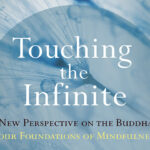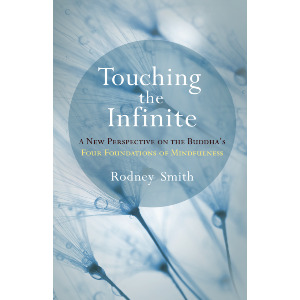We have excerpted a portion of chapter one entitled, “Suffering and the End of Suffering,” from Touching the Infinite: A New Perspective on the Buddha's Four Foundations of Mindfulness here.
During a question-and-answer period after a meditation session I was leading, a student asked where meditation was taking us. He said he was confused by my referencing different end points. Sometimes I would talk about the end of suffering, other times the open heart, and occasionally I might mention becoming fully conscious, and at other times, non-separation. The student said that every time he thought he understood where we were headed, I would change course. Although he thought I was altering the direction of the meditation, in fact I was clarifying the end point by describing it in different ways. I asked him to ponder the question, “What does an end point look like when it simultaneously holds all the different descriptions of it?”
The Buddha, however, was a little more precise. He stated that he taught “only one thing, suffering and its cessation.” It is interesting to ponder why he said he taught only one thing when he seems to have taught many things, including Dependent Origination, the Four Foundations of Mindfulness, the Three Characteristics, the Five Spiritual Faculties, and so on. But why, when asked, did he frame his teaching so explicitly, narrowing it to this single phrase?
One possible explanation is that everything he taught was a tributary to the central flow of his message of suffering and its cessation. Perhaps all his other teachings are either different ways of describing the end point or skillful ways to guide us gently back to this main theme. But I believe there is another overarching reason for paring his teaching down to a single phrase: this simple one-sentence explanation eliminates confusion by providing total clarity of view, intent, direction, and purpose for the entire journey. Following the direction of suffering and its end channels our energy, clarifies our intent, monitors our progress, guides our techniques, and aligns us with our sincerity. When we question what we are doing and why, we have to steer the question through the continuum bounded by suffering and the end of suffering: Does this method I am employing, this effort I am exerting, this goal I am setting, add to or alleviate suffering? Does denial of this fact, avoidance of this difficulty, or procrastination of my responsibility create or lessen struggle for myself and others?
I have noticed over many years of teaching that we all need to be redirected many times back to this central message of our suffering, or else we can easily get sidetracked into following the conclusions of conventional reality that encourage us to deny our problems and project our difficulties onto others. We will never be willing to explore the true origins of our own problems if we are misdirected by our own conditioning as to where to begin that process.
This issue of escapism versus honest exposure to the cause of our conflict can become quite subtle. For example, unless our techniques are specifically referenced to the end of suffering, we can simply use these techniques as ends in themselves. We then meditate to become calm and quiet rather than using that serenity as a tool to further explore our pain. From here we can become dependent upon calming and quieting the mind, which now takes precedence over further exploration of our suffering.
From time to time, we can also become enamored by the powers of mind that many methods cultivate, powers like the laser focus of concentration or states of rapture. The power of concentration can reveal subtle levels of experience that usually remain beyond our normal awareness. These details can be so engrossing within such sublime subtlety that it is like having access to a world normally beyond our power and reach. It then becomes an easy step to arrest our curiosity and interest within this new world and bypass the world of our suffering.
As we move away from the intent to understand why we suffer toward these new worlds, there may be an accompanying anxiety about maintaining access to this new world—and now we are back to suffering. The signals that we have gone astray are always present, but we look easily beyond those cues toward the luster of these newly created experiences and bend our thoughts to support their continued engagement. If we want something besides the complete resolution of our struggles, we will find it along the way. How long we stay within this alternative orbit depends upon both knowing the true direction of the dharma and being honest about our intentions to take that direction.
Begin perceiving your encounters on the continuum that runs from suffering to the end of suffering. Notice the amount of struggle, conflict, tension, and aversion that fills your day. Even pleasant sensations can lead to a struggle if you want that sensation repeated, or you attempt to prolong comfort beyond its natural duration. Become sensitive to the more subtle areas related to suffering; for example, when your thoughts and moods turn sour or your internal narrative is self-berating. Notice the suffering when you desire something that is not present or the aversion to something that is present. Be aware of how your judgments and opinions set you up to be in conflict with another person. Just take it all in and see the entire scope of conflict in your life.
Everything we do on our spiritual journey needs to fit within the context of the overarching theme of the end of struggle, and all our practices need to be questioned from this perspective. For instance, what do following the breath, sitting up straight, releasing our thoughts, walking slowly, sending out loving-kindness, narrowing or expanding our focus, observing our knee pain, questioning our experiences, seeing things clearly, nonjudgmental awareness, choiceless awareness, or even mindfulness have to do with the end of suffering? How are the endless methods we employ held within a coherent direction? What do all these techniques have to do with the struggles of our lives?
These are not theoretical questions. These have everything to do with the perfect alignment of our spiritual path in body, speech, and mind with the complete ending of suffering. We may slip easily away from the Buddha’s clear directive because thought provides its own logic, view, and intention. Our thoughts are conditioned to justify our pleasure seeking and to maintain the status quo, and when left to their own devices will point to our habits and routines. Fortunately for our spiritual growth, the tension inherent in seeking pleasure increases our struggles. Instead of ending suffering we may find ourselves trying to reexperience a peak meditative moment, redirecting our practice toward a deeper level of calm, judging our lack of progress, or avoiding some obvious discomfort.
Thinking attempts to fit life comfortably into our old reasoned patterns of separation, problem resolution, and self-fulfillment. Our thinking keeps avoiding the issue of struggle by focusing on what we are lacking. “Yes, I want to end struggle, but first I must develop more samadhi, tranquility, and balance, then I will be capable of overcoming suffering.” We believe we have to prepare sufficiently to meet our struggles and never realize that much of our suffering comes from that very preparation. Whenever there is more to do there is a built-in tension with the present, and that is a form of struggle.
The logic of our thinking suggests that struggle is something that needs to be overcome no matter what contentious route we take to get there. But an authentic spiritual journey moves counter to that logic by self-monitoring the very methods we use with the end it seeks. Such an authentic path does not bypass the struggle inherent in the technique we are using in order to overcome the suffering of our life; rather, it lives the truth of non-struggle as it encounters the numerous conditioned ways we continue to struggle. It does not add tension to the fire of our own delusion; rather, it moves toward releasing and relinquishing that very tension wherever it is discovered.
$16.95 - Paperback


